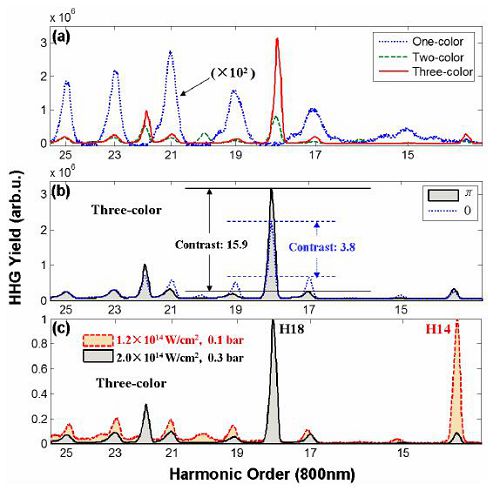Selective enhancement of tunable monochromatic coherent EUV radiation has been generated for the first time by Zhizhan Xu, Ruxin Li group of the Sate Key Laboratory of High Field Laser Physics of Shanghai Institute of Optics and Fine Mechanics, reported by the international physics authoritative academic journal "Physical Review Letters" on June 7, 2013 [Phys. Rev. Lett.110 , 233903 (2013)]. They use multicolor laser field to control the waveform on sub-cycle timescale to selectively enhance specific harmonic radiation, achieving a high contrast ratio (15.9:1).
The high harmonic generation by strong laser field interacting with gas is one key research field of high-field physics. High order harmonics are usually generated like combs with similar strength for different frequencies in the plateau region, which can be attributed to the nonperturbative process of high-order harmonic generation. In order to concentrate the energy to a specific order of high-order harmonics, they first proposed a unique design with sub-cycle waveform control, X-Y polarization controllable multicolor laser field, through macro-phase matching and internal phase-matching of atomic, successfully implementing the greatly enhancement of a specific harmonic and suppression of the adjacent harmonics. This specific harmonic order can be tuned by the phase-matching techniques to obtain the tunable monochromatic coherent EUV radiation output.
In 2000, a group of the University of Colorado and the National Institute of Standards and Technology reported the enhancement of the target harmonic by using a deformable mirror ot optimize chirp characteristics of driving laser pulse (8 times) [Nature 406 , 164 (2000)], but they didn’t suppress the adjacent harmonics, which was not truly selective enhancement. In the following years, there has been no substantial progress. This study is the first breakthrough to achieve selective enhancement of a single high-order harmonic, with the output intensity of 102~3 times (relative to the monochromatic laser field) and the contrast ratio increased to 15.9:1.
The study has important significance and application prospects, as three reviewers have pointed out: "...... This technique is useful in producing a monochromatic coherent XUV source," "...... The work is interesting for applications such as seeding XUV FELs. The mechanism is also interesting because it is related to sub-cycle waveform control, which is currently a hot-topic in high harmonic generation research. "" ...... These results are very interesting and useful for application of high harmonics, because much larger enhancement is obtained, compared with the previously reported methods. "
The research was supported by the National Natural Science Foundation of China, National 973 Program, special fund of the National Key Laboratory of the Ministry of Science.
Paper link:http://link.aps.org/doi/10.1103/PhysRevLett.110.233903
FIG.3 (Color online). (a) Comparison of the maximum harmonic yields driven by the one-color, two-color, and three-color laser fields, respectively. (b) Comparison of the harmonic yields driven by the three-color laser field with two different relative phases, respectively. (c) Comparison of the harmonic yields driven by the three-color laser field with different conditions. The harmonic emission of the selective enhancement can be tuned by controlling the laser intensity and the phase matching parameters.


